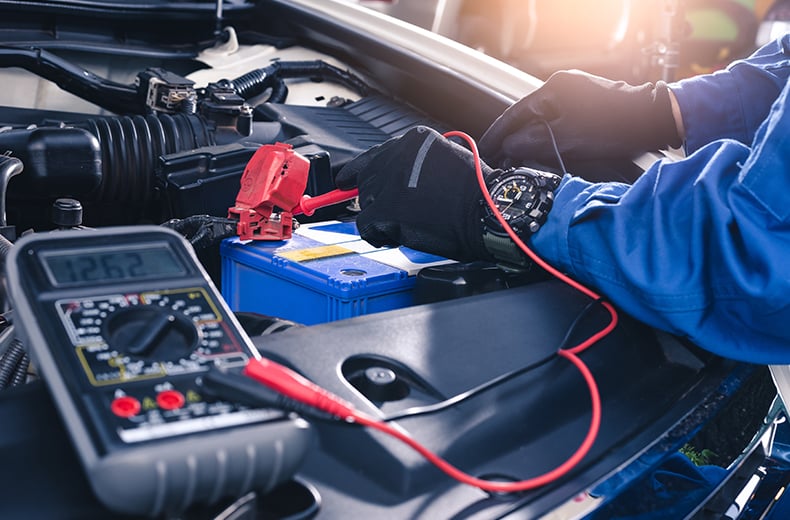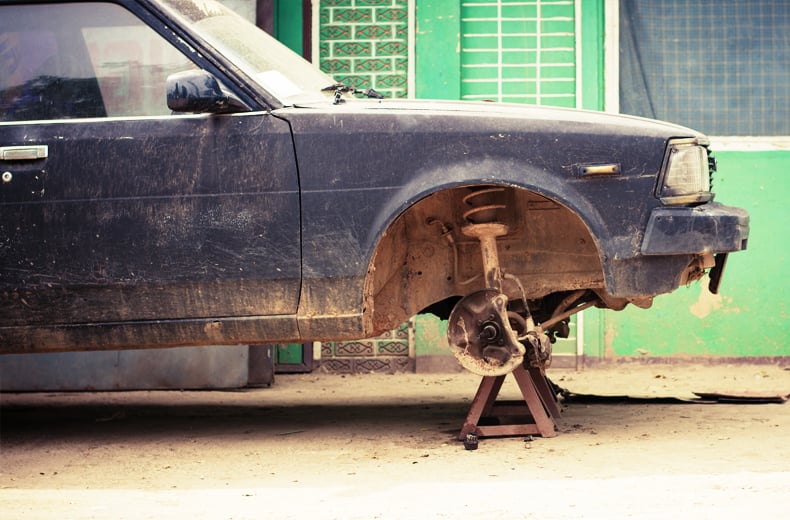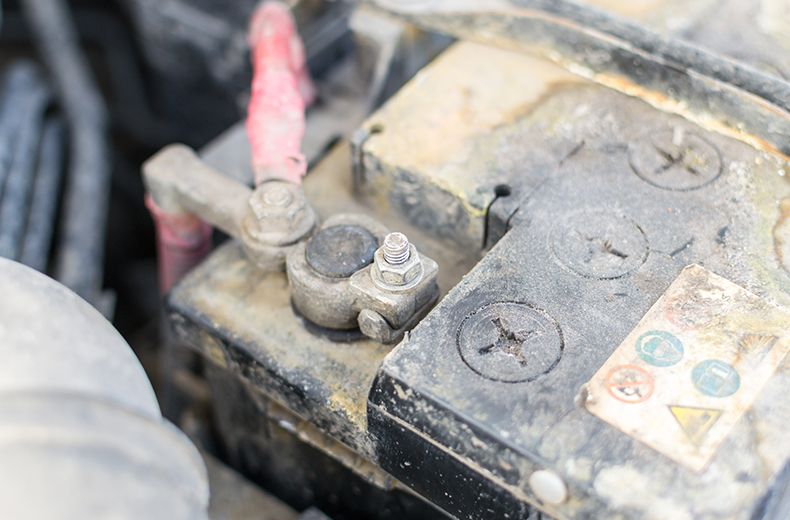So, whether you’ve declared your vehicle off road, or you want your classic car to keep ticking over in storage, find out how a battery conditioner or trickle charger might save you from facing a flat battery.
What are battery conditioners and trickle chargers?
Battery conditioners restore the capacity of lead acid batteries by targeting lead-sulphur deposits which reduce the battery’s ability to hold charge. These deposits build when a car is repeatedly driven on shorter trips or is left unused.
Trickle chargers prevent car batteries from losing enough charge to stop them working. The low-voltage charge is designed to improve the health of your battery on a long-term basis, with a reduced risk of overcharging.
Both are especially useful for second cars, classic cars or any vehicles that aren’t used regularly that you want to keep in a usable condition. Although alternators maintain batteries that are near a full state of charge they’re not designed to recharge a heavily discharged battery.
It’s worth noting that there are 3 main varieties of car batteries:
- AGM - Absorbent Glass Mat
- EFB - Enhanced Flooded Batteries
- SLI - Starting, Lighting, Ignition. These are standard flooded lead acid batteries.
Not all chargers can charge all of these varieties, so always ensure compatibility by reading the manufacturers instructions before you hook up your charger.
How do battery conditioners and trickle chargers work?
Battery conditioners typically dissolve sulphur deposits that build electrical resistance on the plates of batteries1.
The resistance prevents the battery from holding a full charge and can make it appear as though it’s dying.
High-frequency pulses are sent through the battery to bypass its lower current flow and, once a small charge occurs, a higher voltage can be used to regenerate full capacity. Conditioners may also trickle charge the battery to improve its performance.
Trickle chargers top-up batteries at the same rate as self-discharge; the slow process uses a low voltage so the devices can be left for an extended period of time. Check your charger to see if it can be left on a battery indefinitely.
You can find our selection of chargers at the RAC Shop.
How long does a battery conditioner or trickle charger take to work?

The amount of time needed to use a battery conditioner or trickle charger will depend on the condition of the battery and the performance of your conditioner/charger.
A battery conditioner can take up to four weeks to break down lead-sulphate deposits and condition your battery to take a full charge. This does depend on how low the voltage has dropped and the length of time the battery has been left in this condition, though.
A trickle charger can take up to 48 hours to charge a battery to full capacity as most only use one to two amps of power. You can even leave some smarter trickle chargers for days or weeks at a time, but it’s best to check with the manufacturer if this is suitable.

RAC Breakdown Cover
With our cover, the difference is in your pocket.
*£7 a month for new, single vehicle Basic. ^For 1 vehicle with new Extra or Complete. Excludes Basic. Ends 28/05/24, 7am.

The benefits of using battery conditioners and trickle chargers
Battery conditioners will restore the capacity of your battery after its performance drops. They’re particularly useful if you’ve declared a car SORN and left it unattended in storage for an extended period of time.
Trickle chargers are handy for maintaining the performance of your battery before any problems arise. Owners of classic cars or vehicles with weaker batteries can benefit from using the devices to minimise future issues.
How else can I keep my battery healthy?
A booster pack or jump start may help your battery start your engine, but they won’t improve performance in the long term.
Power packs do not target battery capacity or condition. Instead, they simply allow your engine to start, after which your car’s alternator will begin to maintain charge or recharge your battery.
If you plan on not driving your car for a long period of time, it’s best to use a trickle charger before the battery’s capacity reduces. A conditioner that has a float mode should be used after your battery shows signs of holding a lesser charge.
Using these devices could be impractical if your car is parked on the street as you may need to drape cables across the pavement, which can become a tripping hazard for passers-by. So what to do if you can’t use one?
If there are two cars in your household you may want to consider alternating your trips in them. You should also be mindful that repeated short journeys will flatten your battery faster than usual.
Most importantly, you should avoid turning your engine on, only to turn it off again shortly after.
Read more about what to do if you have a flat battery and how to tell you have one.
How to use a battery conditioner or trickle charger
Although they work differently, setting up battery conditioners and trickle chargers are virtually the same:
- Make sure your car is parked in a well-ventilated environment, turn off the ignition and remove the key.
- Select the appropriate power settings for your battery using the device’s controls – most use 12 volts.
- Scrub any corrosion that’s on the posts of the battery with steel wool to ensure a better charging connection.
- Ground the charger by attaching it to a metal part of the engine or chassis to reduce the risk of an electrical surge. On newer cars there may be jump posts specifically for this, it’s worth checking your vehicle handbook if you’re unsure.
- Take the red clip and attach it to the positive terminal on the battery.
- Connect the black clip to the negative terminal on the battery. However, on a modern vehicle the battery negative should not be used as this may bypass the battery management sensor. Again, always consult the vehicle handbook
- Your charger should be turned off and now plugged into the socket.
- Turn on, charge and make sure there are no sparks or heat given off.
Check with the manufacturer to see how long you can leave the product charging your battery.
Are battery conditioners and trickle chargers safe?
It might seem strange to leave something hooked up to your battery for an extended period of time, but these devices are designed to be used in this way.
However, it’s worth checking with the manufacturer how long their products should be left switched on for.
The heat from charging can also lead to off-gassing – the release of an extremely flammable gas that’s unsafe to breathe – so you’ll need to restore your battery in a well-ventilated environment.
You should make sure you charge or condition your battery in a dry environment as well. Check your vehicle handbook to see if the conditioner or trickle charger is suitable for your battery.
More car storage tips

If you’re planning on leaving a car unused, it’s not just the battery you’ll need to look after.
- Take care of your tyres – avoid creating flat spots by inflating your tyres to the maximum recommended pressure. Consider carefully rolling your vehicle so that uneven wear doesn’t develop on the tyres if left for many months.
- Give the car a clean – ensure the environment doesn’t damage your paintwork with a thorough clean and wax
- Park in a suitable place – parking in a sheltered, safe space will not only protect your car from adverse weather, but deter potential thieves from vandals
- Arrange breakdown cover – if your car doesn’t start when it’s needed, you’ll want to be able to call an expert to get on the road again and quickly
Read more detailed tips on how to look after your car from home.
Are you experiencing a car fault, warning, or mechanical problem on your road trip? Find a local mechanic with the RAC.

RAC Breakdown Cover
With our cover, the difference is in your pocket.
*£7 a month for new, single vehicle Basic. ^For 1 vehicle with new Extra or Complete. Excludes Basic. Ends 28/05/24, 7am.

















